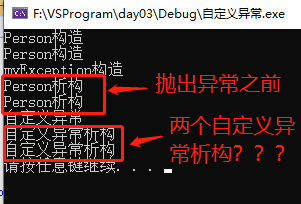概念
异常被抛出后,从进入try块起,到异常被抛掷前,这期间在栈上构造的所有对象,都会被自动析构。析构的顺序与构造的顺序相反,这一过程称为栈的解旋(unwinding).
#define _CRT_SECURE_NO_WARNINGS #include <iostream> using namespace std; class myException { public: myException() { cout << "myException构造" << endl; } void printError() { cout << "自定义异常" << endl; } ~myException() { cout << "自定义异常析构" << endl; } }; class Person { public: Person() { cout << "Person构造" << endl; } ~Person() { cout << "Person析构" << endl; } }; int myDevide(int a, int b) { if (b == 0) { //栈解旋 //从try 开始 到throw抛出异常之前 所有栈上的对象 都会被释放 这个过程称为栈解旋 Person p1; Person p2; //栈解旋2 throw之前 throw myException(); //匿名对象 } return a / b; } void test01() { int a = 10; int b = 0; try { myDevide(a, b); //栈解旋1 try之后 } catch (myException e) { e.printError(); } } int main() { test01(); system("Pause"); return 0; }
结果:

两次析构:
myException类会用拷贝构造出另一个对象给catch (myException e), 所以有两个对象,最后会有两次析构


